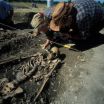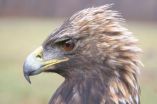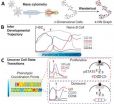(Press-News.org) An international team led by researchers at Uppsala University and Stockholm University reports a breakthrough on understanding the demographic history of Stone-Age humans. A genomic analysis of eleven Stone-Age human remains from Scandinavia revealed that expanding Stone-age farmers assimilated local hunter-gatherers and that the hunter-gatherers were historically in lower numbers than the farmers. The study is published today, ahead of print, in the journal Science.
The transition between a hunting-gathering lifestyle and a farming lifestyle has been debated for a century. As scientists learned to work with DNA from ancient human material, a complete new way to learn about the people in that period opened up. But even so, prehistoric population structure associated with the transition to an agricultural lifestyle in Europe remains poorly understood.
"For many of the most interesting questions, DNA-information from people today just doesn't cut it, the best way to learn about ancient history is to analyze direct data—despite the challenges", says Dr. Pontus Skoglund of Uppsala University, now at Harvard University, and one of the lead authors of the study.
"We have generated genomic data from the largest number of ancient individuals" says Dr. Helena Malmström of Uppsala University and one of the lead authors. "The eleven Stone-Age human remains were between 5,000 and 7,000 years old and associated with hunter-gatherer or farmer life-styles" says Helena Malmström.
Anders Götherström, who led the Stockholm University team, is satisfied with the amount of DNA that they could retrieve.
"Not only were we able to generate DNA from several individuals, but we did get a lot of it. In some cases we got the equivalent of draft genomes. A population genomic study on this level with a material of this age has never been done before as far as I know."
The material used in the study is from mainland Scandinavia as well as from the Baltic island Gotland, and it comprises of hunter-gatherers from various time periods as well as early farmers.
Professor Mattias Jakobsson, who led the Uppsala University team, is intrigued by the results.
"Stone-Age hunter-gatherers had much lower genetic diversity than farmers. This suggests that Stone-Age foraging groups were in low numbers compared to farmers", says Mattias Jakobsson.
Jan Storå at Stockholm University shares Mattias' fascination.
"The low variation in the hunter gatherers may be related to oscillating living conditions likely affecting the population sizes of hunter-gatherers. One of the additional exciting results is the association of the Mesolithic individual to both the roughly contemporaneous individual from Spain but also the association to the Neolithic hunter-gatherers."
The study confirms that Stone-Age hunter-gatherers and farmers were genetically distinct and that migration spread farming practices across Europe, but the team was able to go even further by demonstrating that the Neolithic farmers had substantial admixture from hunter-gatherers. Surprisingly, the hunter-gatherers from the Baltic Sea displayed no evidence of introgression from farmers.
"We see clear evidence that people from hunter-gatherer groups were incorporated into farming groups as they expanded across Europe", says Pontus Skoglund. "This might be clues towards something that happened also when agriculture spread in other parts of the world."
"The asymmetric gene-flow shows that the farming groups assimilated hunter-gatherer groups, at least partly", says Mattias Jakobsson. "When we compare Scandinavian to central European farming groups that lived at about the same time, we see greater levels of hunter-gatherer gene-flow into the Scandinavian farming groups."
This study is part of the recently initiated "Atlas project" - a large-scale genomic investigation of ancient human remains in Scandinavia led by Stockholm and Uppsala Universities and funded by the Swedish Foundation for Humanities and Social Sciences and the Swedish Research Council. The present study brings the first results from the project.
"We have only begun to scratch the surface of the knowledge that this project may bring us in the future" says Anders Götherström.
INFORMATION:
For more information, please contact:
Mattias Jakobsson
e-mail: mattias.jakobsson@ebc.uu.se
office: +46 18 4716449
cell: +46 767 698169
Anders Götherström
e-mail: tsarapkin@gmail.com
cell: +46 73 992 7864
Pontus Skoglund
e-mail: skoglund@genetics.med.harvard.edu
cell: 0768393733
Helena Malmström
e-mail: helena.malmstrom@ebc.uu.se
cell: +46707442444
Jan Storå
e-mail: jan.stora@ofl.su.se
office: +46 8 161287
cell: +46 706 052293
Genomic diversity and admixture differs for Stone-Age Scandinavian foragers and farmers
2014-04-24
ELSE PRESS RELEASES FROM THIS DATE:
Some corals adjusting to rising ocean temperatures, Stanford researchers say
2014-04-24
To most people, 86-degree Fahrenheit water is pleasant for bathing and swimming. To most sea creatures, however, it's deadly. As climate change heats up ocean temperatures, the future of species such as coral, which provides sustenance and livelihoods to a billion people, is threatened.
Through an innovative experiment, Stanford researchers led by biology Professor Steve Palumbi have shown that some corals can – on the fly – adjust their internal functions to tolerate hot water 50 times faster than they would adapt through evolutionary change alone. The findings, published ...
Genetic code of the deadly tsetse fly unraveled
2014-04-24
A decade-long effort by members of the International Glossina Genome Initiative (IGGI) has produced the first complete genome sequence of the tsetse fly, Glossina morsitans. The blood-sucking insect is the sole transmitter of sleeping sickness, a potentially deadly disease endemic in sub-Saharan Africa. The vast store of genetic data will help researchers develop new ways to prevent the disease and provide insights into the tsetse fly's unique biology.
The tsetse fly is quite unique in the insect world: it feeds exclusively on the blood of humans and animals, gives birth ...
Study finds accelerated soil carbon loss, increasing the rate of climate change
2014-04-24
Research published in Science today found that increased levels of carbon dioxide in the atmosphere cause soil microbes to produce more carbon dioxide, accelerating climate change.
Two Northern Arizona University researchers led the study, which challenges previous understanding about how carbon accumulates in soil. Increased levels of CO2 accelerate plant growth, which causes more absorption of CO2 through photosynthesis.
Until now, the accepted belief was that carbon is then stored in wood and soil for a long time, slowing climate change. Yet this new research suggests ...
The Ancient Maya and virtual worlds: Different perspectives on material meanings
2014-04-24
If Facebook were around 1,400 years ago, the ancient Maya might have been big fans of the virtual self.
The Maya believed that part of your identity could inhabit material objects, like a courtier's mirror or sculptor's carving tool. Maya might even name these objects, talk to them or take them to special events. They considered these items to be alive.
The practice of sharing your identity with material possessions might seem unusual in a modern context.
But is it that different from today's selfie-snapping, candy-crushing online culture, where social media profiles ...
Autism Genome Project delivers genetic discovery
2014-04-24
NEW YORK, N.Y. (April 24, 2014) – A new study from investigators with the Autism Genome Project, the world's largest research project on identifying genes associated with risk for autism, has found that the comprehensive use of copy number variant (CNV) genetic testing offers an important tool in individualized diagnosis and treatment of autism.
Funded primarily by Autism Speaks, the world's leading autism science and advocacy organization, the Autism Genome Project involved more than 50 research centers in 11 countries. The report, published today in the American Journal ...
Measles commentary in Annals of Internal Medicine
2014-04-24
1. Measles outbreaks prompt concern about physician knowledge gaps
Vaccination refusal and importation of the disease has led to increased incidence of measles in the United States. Before widespread vaccination, approximately 500,000 measles cases occurred annually, resulting in 500 deaths and 48,000 hospitalizations. Vaccination programs helped to eradicate endemic measles by the year 2000, reducing the median number of cases per year to 60. But in just the first three months of 2014, 106 measles cases were reported, prompting health officials to become concerned. Measles ...
Plants send out signals attracting harmful bacteria, MU study finds
2014-04-24
COLUMBIA, Mo. – When bacteria attack plants, they often inject harmful proteins into the host plants' cells to weaken and suppress natural defenses. However, in some plants, bacteria attack once they've recognized the plant cells as a potential host. Now, researchers at the University of Missouri have identified and replicated the process that allows the bacteria—known mostly for attacking tomatoes—to invade its host. This discovery could lead to natural anti-infective treatments that work with food-producing plants to enhance resistance to harmful bacteria in the field.
"When ...
Genome yields insights into golden eagle vision, smell
2014-04-24
WEST LAFAYETTE, Ind. - Purdue and West Virginia University researchers are the first to sequence the genome of the golden eagle, providing a bird's-eye view of eagle features that could lead to more effective conservation strategies.
Their study calls into question long-held assumptions about golden eagle vision, indicating that the raptors may not be as sensitive to ultraviolet light as previously thought. The genome also suggests that golden eagles could have a sharper sense of smell than researchers realized.
Additionally, the genome provides thousands of genetic ...
International collaboration unravels novel mechanism for neurological disorder
2014-04-24
HOUSTON – (April 24, 2014) – A team of international scientists led by Baylor College of Medicine has discovered a novel gene (CLP1) associated with a neurological disorder affecting both the peripheral and central nervous systems. Together with scientists in Vienna they show that disturbance of a very basic biological process, tRNA biogenesis, can result in cell death of neural progenitor cells. This leads to abnormal brain development and a small head circumference as well as dysfunction of peripheral nerves.
The study published today in the current issue of the journal ...
Researchers create comprehensive map of human B cell development
2014-04-24
New York, NY - In the April 24, 2014 edition of Cell, a team of researchers led by Dana Pe'er at Columbia University and Garry Nolan at Stanford University describes a powerful new method for mapping cellular development at the single cell level. By combining emerging technologies for studying single cells with a new, advanced computational algorithm, they have created the most comprehensive map ever made of human B cell development. Their approach will greatly improve researchers' ability to investigate development in cells of all types, make it possible to identify rare ...






